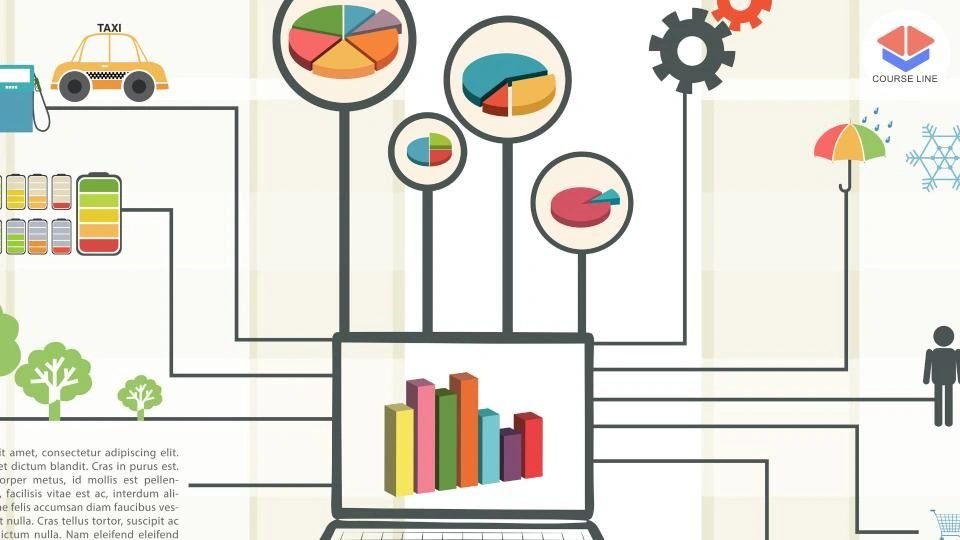Course Features
Price
Study Method
Online | Self-paced
Course Format
Reading Material - PDF, article
Duration
5 hours, 35 minutes
Qualification
No formal qualification
Certificate
At completion
Additional info
Coming soon
- Share
Overview
The Geospatial Data Analysis Level 3 Advanced Diploma offers an in-depth exploration of the principles, tools, and techniques used in analysing and visualising spatial data. Starting with a foundational overview of geospatial analysis, the course introduces Geographic Information Systems (GIS) and remote sensing—two essential technologies that support data-driven insights across multiple disciplines including environmental science, urban planning, agriculture, and disaster management.
Throughout the course, students will explore the various types of spatial data formats such as vector and raster, learn about coordinate systems, and examine common file types like shapefiles and GeoTIFFs. The curriculum provides practical instruction on acquiring data from satellite imagery and aerial sources, alongside preprocessing methods such as image enhancement and georeferencing to prepare data for meaningful analysis.
Advanced spatial analysis methods, including interpolation, overlay operations, and buffer analysis, are covered in detail. The course also delves into statistical and geostatistical approaches, including kriging, spatial regression, and the integration of machine learning techniques for geospatial prediction and pattern recognition. Learners will gain practical experience in remote sensing applications such as land use classification and environmental monitoring.
In the later modules, emphasis is placed on managing geospatial data using robust databases, designing metadata standards, and applying effective visualisation techniques for creating impactful interactive maps. Ethical and legal considerations are also discussed to ensure students are aware of privacy concerns, data governance, and regulatory frameworks relevant to geospatial projects.
By the end of this course, students will possess the technical skills and theoretical knowledge to work confidently with geospatial data, making them valuable assets in roles that require spatial intelligence and analytical decision-making.
Graduates of this course can pursue a wide range of career opportunities in sectors such as environmental consulting, urban and regional planning, disaster management, public health, natural resource management, transportation planning, and geospatial intelligence. This qualification also serves as a stepping stone for advanced studies or roles in GIS development, remote sensing analysis, and spatial data science.
Who is this course for?
The Geospatial Data Analysis Level 3 Advanced Diploma offers an in-depth exploration of the principles, tools, and techniques used in analysing and visualising spatial data. Starting with a foundational overview of geospatial analysis, the course introduces Geographic Information Systems (GIS) and remote sensing—two essential technologies that support data-driven insights across multiple disciplines including environmental science, urban planning, agriculture, and disaster management.
Throughout the course, students will explore the various types of spatial data formats such as vector and raster, learn about coordinate systems, and examine common file types like shapefiles and GeoTIFFs. The curriculum provides practical instruction on acquiring data from satellite imagery and aerial sources, alongside preprocessing methods such as image enhancement and georeferencing to prepare data for meaningful analysis.
Advanced spatial analysis methods, including interpolation, overlay operations, and buffer analysis, are covered in detail. The course also delves into statistical and geostatistical approaches, including kriging, spatial regression, and the integration of machine learning techniques for geospatial prediction and pattern recognition. Learners will gain practical experience in remote sensing applications such as land use classification and environmental monitoring.
In the later modules, emphasis is placed on managing geospatial data using robust databases, designing metadata standards, and applying effective visualisation techniques for creating impactful interactive maps. Ethical and legal considerations are also discussed to ensure students are aware of privacy concerns, data governance, and regulatory frameworks relevant to geospatial projects.
By the end of this course, students will possess the technical skills and theoretical knowledge to work confidently with geospatial data, making them valuable assets in roles that require spatial intelligence and analytical decision-making.
Graduates of this course can pursue a wide range of career opportunities in sectors such as environmental consulting, urban and regional planning, disaster management, public health, natural resource management, transportation planning, and geospatial intelligence. This qualification also serves as a stepping stone for advanced studies or roles in GIS development, remote sensing analysis, and spatial data science.
Requirements
The Geospatial Data Analysis Level 3 Advanced Diploma offers an in-depth exploration of the principles, tools, and techniques used in analysing and visualising spatial data. Starting with a foundational overview of geospatial analysis, the course introduces Geographic Information Systems (GIS) and remote sensing—two essential technologies that support data-driven insights across multiple disciplines including environmental science, urban planning, agriculture, and disaster management.
Throughout the course, students will explore the various types of spatial data formats such as vector and raster, learn about coordinate systems, and examine common file types like shapefiles and GeoTIFFs. The curriculum provides practical instruction on acquiring data from satellite imagery and aerial sources, alongside preprocessing methods such as image enhancement and georeferencing to prepare data for meaningful analysis.
Advanced spatial analysis methods, including interpolation, overlay operations, and buffer analysis, are covered in detail. The course also delves into statistical and geostatistical approaches, including kriging, spatial regression, and the integration of machine learning techniques for geospatial prediction and pattern recognition. Learners will gain practical experience in remote sensing applications such as land use classification and environmental monitoring.
In the later modules, emphasis is placed on managing geospatial data using robust databases, designing metadata standards, and applying effective visualisation techniques for creating impactful interactive maps. Ethical and legal considerations are also discussed to ensure students are aware of privacy concerns, data governance, and regulatory frameworks relevant to geospatial projects.
By the end of this course, students will possess the technical skills and theoretical knowledge to work confidently with geospatial data, making them valuable assets in roles that require spatial intelligence and analytical decision-making.
Graduates of this course can pursue a wide range of career opportunities in sectors such as environmental consulting, urban and regional planning, disaster management, public health, natural resource management, transportation planning, and geospatial intelligence. This qualification also serves as a stepping stone for advanced studies or roles in GIS development, remote sensing analysis, and spatial data science.
Career path
The Geospatial Data Analysis Level 3 Advanced Diploma offers an in-depth exploration of the principles, tools, and techniques used in analysing and visualising spatial data. Starting with a foundational overview of geospatial analysis, the course introduces Geographic Information Systems (GIS) and remote sensing—two essential technologies that support data-driven insights across multiple disciplines including environmental science, urban planning, agriculture, and disaster management.
Throughout the course, students will explore the various types of spatial data formats such as vector and raster, learn about coordinate systems, and examine common file types like shapefiles and GeoTIFFs. The curriculum provides practical instruction on acquiring data from satellite imagery and aerial sources, alongside preprocessing methods such as image enhancement and georeferencing to prepare data for meaningful analysis.
Advanced spatial analysis methods, including interpolation, overlay operations, and buffer analysis, are covered in detail. The course also delves into statistical and geostatistical approaches, including kriging, spatial regression, and the integration of machine learning techniques for geospatial prediction and pattern recognition. Learners will gain practical experience in remote sensing applications such as land use classification and environmental monitoring.
In the later modules, emphasis is placed on managing geospatial data using robust databases, designing metadata standards, and applying effective visualisation techniques for creating impactful interactive maps. Ethical and legal considerations are also discussed to ensure students are aware of privacy concerns, data governance, and regulatory frameworks relevant to geospatial projects.
By the end of this course, students will possess the technical skills and theoretical knowledge to work confidently with geospatial data, making them valuable assets in roles that require spatial intelligence and analytical decision-making.
Graduates of this course can pursue a wide range of career opportunities in sectors such as environmental consulting, urban and regional planning, disaster management, public health, natural resource management, transportation planning, and geospatial intelligence. This qualification also serves as a stepping stone for advanced studies or roles in GIS development, remote sensing analysis, and spatial data science.
-
- Overview of geospatial data analysis 00:10:00
- Importance and applications of geospatial data 00:10:00
- Introduction to GIS (Geographic Information Systems) and remote sensing 00:10:00
-
- Types of spatial data (vector vs. raster) 00:10:00
- Common GIS file formats (shapefiles, GeoTIFF, etc.) 00:10:00
- Coordinate systems and projections 00:10:00
- Sources of geospatial data 00:10:00
- Data acquisition techniques and considerations 00:10:00
- Preprocessing steps (image enhancement, georeferencing, etc.) 00:10:00
- Spatial statistics and modeling 00:10:00
- Geostatistical analysis techniques 00:10:00
- Machine learning for geospatial analysis 00:10:00
- Data storage and retrieval 00:10:00
- Database design for spatial data 00:10:00
- Metadata standards and documentation 00:10:00
- Ethical considerations in geospatial data analysis 00:10:00
- Privacy concerns and data protection measures 00:10:00
- Legal and regulatory frameworks 00:10:00
- Premium Certificate 00:15:00

No Reviews found for this course.
Is this certificate recognized?
Yes, our premium certificate and transcript are widely recognized and accepted by embassies worldwide, particularly by the UK embassy. This adds credibility to your qualification and enhances its value for professional and academic purposes.
I am a beginner. Is this course suitable for me?
Yes, this course is designed for learners of all levels, including beginners. The content is structured to provide step-by-step guidance, ensuring that even those with no prior experience can follow along and gain valuable knowledge.
I am a professional. Is this course suitable for me?
Yes, professionals will also benefit from this course. It covers advanced concepts, practical applications, and industry insights that can help enhance existing skills and knowledge. Whether you are looking to refine your expertise or expand your qualifications, this course provides valuable learning.
Does this course have an expiry date?
No, you have lifetime access to the course. Once enrolled, you can revisit the materials at any time as long as the course remains available. Additionally, we regularly update our content to ensure it stays relevant and up to date.
How do I claim my free certificate?
I trust you’re in good health. Your free certificate can be located in the Achievement section. The option to purchase a CPD certificate is available but entirely optional, and you may choose to skip it. Please be aware that it’s crucial to click the “Complete” button to ensure the certificate is generated, as this process is entirely automated.
Does this course have assessments and assignments?
Yes, the course includes both assessments and assignments. Your final marks will be determined by a combination of 20% from assignments and 80% from assessments. These evaluations are designed to test your understanding and ensure you have grasped the key concepts effectively.
Is this course accredited?
We are a recognized course provider with CPD, UKRLP, and AOHT membership. The logos of these accreditation bodies will be featured on your premium certificate and transcript, ensuring credibility and professional recognition.
Will I receive a certificate upon completion?
Yes, you will receive a free digital certificate automatically once you complete the course. If you would like a premium CPD-accredited certificate, either in digital or physical format, you can upgrade for a small fee.
Course Features
Price
Study Method
Online | Self-paced
Course Format
Reading Material - PDF, article
Duration
5 hours, 35 minutes
Qualification
No formal qualification
Certificate
At completion
Additional info
Coming soon
- Share
Business Writing Level 3 Advanced Diploma
Course Line237£490.00Original price was: £490.00.£14.99Current price is: £14.99.Painting and Decorating Level 8 Advanced Diploma
Course Line242£490.00Original price was: £490.00.£14.99Current price is: £14.99.Headteacher Level 3 Advanced Diploma
Course Line238£490.00Original price was: £490.00.£14.99Current price is: £14.99.





